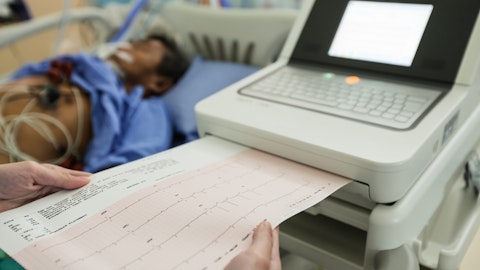Longeveron Inc. (NASDAQ:LGVN) Q4 2022 Earnings Call Transcript March 10, 2023
Operator: Good morning, and welcome to Longeveron’s call today to discuss the company’s 2022 Fourth Quarter and Full Year Financial Results. I would now like to turn the call over to James Clavijo, Longeveron’s Chief Financial Officer. James, you may proceed.
James Clavijo: Thank you, operator. Good morning, everyone, and welcome to Longeveron’s Fourth Quarter and Full Year 2022 Call. Today, we will provide a business update and discuss financial results for the fourth quarter and full year of 2022. Earlier this morning, we issued a press release with these results, which can be found under the Investors section of our website at www.longeveron.com. I am joined on the call today by the following members of Longeveron’s management team: Mr. Wa’el Hashad, Chief Executive Officer; Dr. Chris Min, Chief Medical Officer; and Dr. Joshua Hare, Co-Founder, Chief Scientific Officer and Chairman. Mr. Hashad will begin with a brief corporate overview, Dr. Min will follow by a review of updates from Longeveron’s clinical programs and Hypoplastic Left Heart Syndrome or HLHS, Alzheimer’s disease and aging-related frailty, after which I will review our 2022 fourth quarter and full year financial results.
Lastly, we will open the call for Q&A. As a reminder, during this call, we will be making forward-looking statements, which are subject to various risks and uncertainties that could cause our actual results to differ materially from these statements. Any such statements should be considered in conjunction with cautionary statements in our press releases and risk factors discussions in our filings with the SEC, including our annual report on Form 10-K and cautionary statements made during this call. We assume no obligation to update any of these forward-looking statements or information. Now I’d like to turn the call over to Mr. Wa’el Hashad, Chief Executive Officer of Longeveron. Wa’el?
Wa’el Hashad: Thank you, James. Good morning, everyone. Welcome to Longeveron Fourth Quarter and full 2022 business update and financial results. Thank you for joining us today. Longeveron is a clinical stage biotechnology company, developing regenerative medicine for unmet medical needs. We had productive 2022 executing multiple key milestones and advancing our lead investigational product, Lomecel-B, across multiple indications. I am honored to have recently joined Longeveron as the Chief Executive Officer. I’m excited by the broad therapeutic potential of Lomecel-B and the great progress that has been made already to date. I look forward to working alongside the outstanding Longeveron own team to build on this progress for the rest of 2023 and beyond.
Our lead investigational product called Lomecel-B, it is a living cell product made from a specialized cell isolated from bone marrow of young healthy adult donors aged 18 to 45. These specialized cells are known in the literature as medicinal signaling cells or MSCs and are essential to our endogenous repair mechanism. MSCs are known to perform a number of complex functions, including the ability to form new tissue. They also hone to sites of injuries or disease and secrete bioactive factors that are immunomodulatory and regenerative. We believe that Lomecel-B has multiple mechanisms of action that may lead to anti-inflammatory provascular regenerative responses and therefore, may have broad application for a range of rare and aging-related diseases.
In the fourth quarter of 2022, we continue to make progress in advancing Lomecel-B for our suite of rare diseases and aging-related diseases. We have ongoing Phase II trial in Hypoplastic Left Heart Syndrome, also known as HLHS, Alzheimer’s disease and aging-related relate. In HLHS, we are currently conducting our ELPIS II Phase II randomized controlled study to determine whether Lomecel-B improves the conditions of infants with this life-threatening condition. In addition, in our aging-related frailty program, we are conducting a Phase II study in Japan and expect to randomize our first patient in this study by the end of this quarter. I’ll now turn the call over to Dr. Chris Min, Longeveron’s Chief Medical Officer, who will provide additional updates on the progress we made in our clinical program.
Chris?
Dr. Chris Min: Thank you, Wa’el, and good morning, everyone. First, I’ll begin with an update on our HLHS program. As a reminder, HLHS is a rare congenital heart defect that affects approximately 1,000 infants per year in the United States. People born with HLHS have an underdeveloped or absent left ventricle, impairing the heart’s ability to pump blood. Left untreated, this condition is always fatal. The current standard of care comprised of 3 reconstructive operations before the age of 5, an extraordinary treatment burden for these young pediatric patients. Further, even with these surgical interventions, children with HLHS are at elevated risk of short-term mortality, delay development and long-term complications, including organ failure, with only somewhere between 50% to 60% surviving to adolescents.
There exists a tremendous unmet need for additional interventions beyond the current standard of care, and we believe that Lomecel-B with its proregenerative, provascular and anti-inflammatory properties when administered concurrently with surgical intervention can fill that gap by improving cardiac performance in patients with HLHS. We are currently conducting a randomized controlled study in which Lomecel-B is administered to infants during Stage II surgery. Our cell product is administered in an approximately 5-minute intraoperative procedure, with injections directly into the . The primary endpoint of this study is with ejection fraction, consider the best functional endpoint for this condition. Based on the previous Phase I study in 10 patients with HLHS, the FDA has granted Lomecel-B rare pediatric disease, orphan drug and fast track designations for the treatment of HLHS.
Next, I’ll move on to our aging-related frailty program. Aging-related frailty is an age associated decline and reversal in function across multiple physiologic systems that leads to an inability to cope with stressors. This is common among the elderly, affecting millions of individuals in the United States, up to 15% of the population over the age of 65. Aging-related frailty manifests typically as a combination of several sizes and systems that may include sarcopenia or involuntary loss on muscle, the associated weakness, fatigue, weight loss, slowness and low activity. Unfortunately, elderly frail individuals are more vulnerable to poor clinical outcomes associated with aging-related frailty such as infection, hospitalizations and even death.
At Longeveron, we have been evaluating the effect of Lomecel-B that it may have on the health and function of these elderly frail patients, particularly on their physical immune system function. In early stage exploratory trials, we have been using biomarkers of inflammation and vascular and endothelial function to measure this effect. Our clinical development strategy in aging-related frailty is currently focused on Japan, which has one of the oldest populations in the world. This quarter, we continue screening patients for our Phase II study evaluating Lomecel-B in patients with aging-related frailty in Japan in partnership with the National Center for Geriatrics and Gerontology and Nagoya and Juntendo University Hospital in Tokyo. The Phase II clinical trial is a 3-arm parallel design randomized, placebo-controlled, double-blind, single infusion study of 2 different dose levels of Lomecel-B.
The primary objective of the study is to evaluate the safety of Lomecel-B as a treatment for aging-related frailty, with an overarching goal of providing support for an eventual limited approval under the Act on the Safety of Regenerative Medicine, or ASRM, which recognizes the tremendous therapeutic potential of cell therapies. A potential ASRM approval could enable us to enter the Japanese market based on demonstrated safety in Japanese patients with an expectation of efficacy which can be established through the conduct of a small, well-controlled trial in Japanese patients combined with our previous data in aging-related frailty. Such an approval would allow us to administer Lomecel-B as a treatment for aging-related frailty at select clinical sites, addressing a crucial unmet need amongst the Japanese population and we expect to randomize our first patient in this Phase II trial this quarter.
Finally, I’d like to cover updates on our Alzheimer’s disease program. In November, we were pleased to announce the completion of enrollment of our Phase IIa trial. As a reminder, this trial called the CLEAR MIND trial, is a 48-patient 4-arm parallel design, randomized and placebo-controlled trial of Lomecel-B designed to evaluate the safety of single and multiple infusions of 2 different dose levels of Lomecel-B compared to placebo in patients with mild Alzheimer’s disease. Our primary endpoint is safety, as measured by the occurrence of serious adverse events within the first 30 days after the administration of Lomecel-B. Secondary and exploratory endpoints include brain volume actuary by magnetic resonance imaging, biomarkers relevant to inflammation and endothelin vascular systems and, of course, measures of cognitive function.
Each patient is followed in the study for a duration of 9 months. Based on a robust study of preclinical and clinical data, we believe Lomecel-B may prevent, slow or even reverse the clinical progression of Alzheimer’s disease by reducing disease-related brain information. Neuronal cell death caused by early and substantial neuroinflammation is a significant contributor to the pathogenesis of Alzheimer’s disease. In preclinical models of Alzheimer’s disease MSCs like Lomecel-B have been shown to cross the blood brain barrier potentially with an anti-inflammatory effect, improving endothelin function and promoting neurogenesis, the process of new neuron formation in the brain. In our previously completed Phase Ib in the study — Phase Ib study in alzheimer’s patients, we demonstrated the preliminary safety of Lomecel-B in patients with wild-to-moderate Alzheimer’s disease.
With this Phase IIa trial, we hope to build on this body of evidence. We expect to share the top line results in early 2024. With that, I’d now like to turn the call over to James Clavijo, our Chief Financial Officer, to discuss our financial results for the fourth quarter and full year of 2022. James?
James Clavijo: Thanks, Chris. Most of what I’ll be covering this morning will be presented in more detail in our condensed financial statements and our management’s discussion and analysis of operations for the year ended December 31, 2022. The fourth quarter and full year ended December 31, 2022, revenue. Revenue in the fourth quarter 2022 was $0.1 million compared to $0.2 million in the same period of ’21. The difference was primarily due to a decrease in clinical trial revenue during the fourth quarter 2022. During this quarter, fewer participants decided on having the treatment as compared to ’21. Revenue for the full year ’22 was $1.2 million compared to $1.3 million in 2021. Clinical trial revenue was $0.9 million for ’22 compared to $0.7 million for 2021, an increase of $0.2 million or 29%.
Participations increased in 2022 as compared to 2021 as the effects of travel restrictions due to COVID-19 decreased. Revenue was $0.3 million for ’22 compared to $0.6 million for ’21, a decrease of $0.3 million or 53%, which was primarily due to a reduction in grant funds available due in part to the completion of some of our grant-funded clinical trials. General and administrative expenses in the fourth quarter of ’22 were $1.6 million compared to $2.1 million for the same period in ’21. The decrease of approximately $0.5 million or 24% was primarily related to a decrease in equity-based compensation expenses and professional fees. General and administrative expenses for full year ’22 were $8.1 million compared to $9.7 million for ’21, the decrease of approximately $1.6 million or 16% was primarily related to a decrease of $3 million in equity-based compensation expenses allocated to G&A expenses.
However, employee benefit expenses did increase by $0.5 million, which included a $0.4 million increase in expenses related to employee recruitment, and insurance and professional fees increased by . Research and development expenses in the fourth quarter of 2022 were $3.2 million compared to $1.7 million for the same period in 2021. The increase of $1.5 million or 88% was primarily due to an increase in research and development expenses related to the completion of clinical trials that were not reimbursable by grants. R&D expenses for full year 2022 were $9.4 million compared to $7.1 million for 2021. The increase of $2.3 million or 32% was primarily due to an increase in research and development expenses related to the completion of clinical trials that were not reimbursable by grants.
The increase was offset by a decrease in equity-based compensation allocated to research and development expenses, which decreased from $2.2 million in 2021 to $1.1 million in 2022. Selling and marketing expenses in the fourth quarter of 2022 and 2021 were $0.3 million. Selling and marketing expenses for the full year 2022 were $1 million compared to $1.2 million for 2021. The decrease of $0.2 million or 17% was primarily due to a decrease in digital marketing expenses. Selling and marketing expenses consist primarily of investor and public relations expenses. Further, and as disclosed in Note 13 reclassification of prior year presentations on the Form 10-K during 2021, $0.9 million in expenses related to investor and public relations that were recorded as general and administrative expenses and were reclassified as selling and marketing expenses as they were in 2022.
Our net loss was $4.5 million in the fourth quarter of 2022 compared to $4.1 million for the same period in 2021. Net loss for the full year was $18.8 million compared to $17 million in 2021. Our cash and short-term investments was $19.6 million compared to $35 million as of December 31 in 2022 and 2021, respectively. The decrease in cash period-over-period was a result of use of funds for operations. As a reminder, during 2021, we received gross proceeds from our initial public offering in February 2021 and our subsequent private placement offering in December 2021 of over $49.6 million. Based on the company’s current operating plan and financial resources, we believe that our existing cash and short-term investments will be sufficient to cover expenses and capital requirements well into the first quarter of 2024.
With that, thank you, and I will turn the call back to Wa’el.
Wa’el Hashad: Thank you, James. As you are here today, we have made strong progress in 2022, and we look forward to building on this momentum and sharing additional updates in 2023. I would like now to open the call for questions. So operator?
Q&A Session
Follow Logicvision Inc
Follow Logicvision Inc
Operator: The first question today comes from the line of Michael Okunewitch from Maxim Group.
Michael Okunewitch: Wa’el, congratulations on coming aboard. I guess — so I guess, first off, there was recently some activity in this space. We recently saw that the FDA accepted the BLA for Mesoblast for remestemcel-L in GVHD. So I’d like to see if there are any takeaways from the new inclusions in their refiled BLA that you can or already have applied to your programs to ensure a more streamlined regulatory workflow.
Wa’el Hashad: So Michael, I will take a stab in answering this, and — but I will ask also Chris to add any additional comments related to this. First and foremost, we definitely are encouraged by the fact that the FDA have accepted the application from Mesoblast. And we believe that for — specifically for conditions of rare diseases that definitely the path to regulatory approval is much faster than typical other indications. We are doing here in — at Longeveron, we’re doing all the right setup for our trial to hopefully meet the criteria if we are able to achieve the results that we hope to achieve to possibly have it filed with the FDA and potentially get an indication once the trial is being concluded. But I will let Chris to add any specific comments on — from his side.
Dr. Chris Min: Yes. Thank you, Wa’el. So Michael, to be frank, we haven’t certainly made any changes or adjustments immediately. We are definitely setting their application closely. I would point out that our indication is an ultra-rare indication and a cardiac indication. We have our own strategy that we’re forming and — but we will definitely keep a close eye on Mesoblast’s activities and try to leverage anything that we can glean from their approach.
Michael Okunewitch: All right. And then just on the HLHS program, I’d like to see if you could provide a bit more color on the enrollment and how you view that regulatory pathway given your existing interactions with FDA, as you mentioned, it’s an ultra rarepediatric disease. So do you think you would need an additional study or would help us to potentially support accelerated or even full approval given how significant the unmet need is here?
Dr. Chris Min: Wa’el, would you allow me to address that question?
Wa’el Hashad: Absolutely. Go ahead, Chris.
Dr. Chris Min: Okay. So Michael those are good points. And I certainly would not give a definitive answer about those questions. However, I would acknowledge, as you pointed out that given that this is an ultra-rare indication, that there are potential — there is a potential that our current Phase II trial, if it has a positive outcome could serve potentially as a pivotal study, we would be planning depending on the outcome of the study to ask those questions of the agency and even prior to submission. Because we do have these avenues of communication with the orphan disease, rare disease and fast track designations, we intend to utilize our access to the agency to ask questions even before the completion of the study regarding aspects of that future end of Phase II/discussion of what the study could represent.
And so our — we don’t presume that it will serve as a pivotal study, but we will definitely ask the agency about the possibility of consideration for those designations such as a pivotal study, such as accelerated approval and so on.
Michael Okunewitch: All right. And then just 1 last for me, and I’ll hop back in the queue. I wanted to ask on the alzheimer study. Which endpoints are you most focused on for the evaluation of efficacy? Obviously, function is key, but it’s a smaller study. So I’d like to get your take on how you look at the importance of the different biomarkers and anatomical measures that you’re evaluating.
Dr. Chris Min: So in that trial, as you pointed out, we certainly wouldn’t project that we would definitively determine efficacy of almost in such a small trial with 12 patients per arm. In order to try to enhance the ability to glean an efficacy signal, we’re taking a combined endpoint approach where we’re combining several of the cognitive endpoints. And then in terms of the biomarker for efficacy, the key endpoint we’re combining into that global assessment is the volumetric hippocampal volume, which is being determined by a central blinded read that is looking, and we are also obtaining high-field magnet, high to get the best anatomical resolution we can. And so we’re going to combine that imaging measure combined with these cognitive measures to try to glean an efficacy signal.
Operator: There are no additional questions waiting at this time. So I’d like to pass the conference back over to Mr. Wa’el Hashad for any closing remarks.
Wa’el Hashad: Thank you. On behalf of the company, I would like to thank everyone for their continued interest and support for Longeveron and have a great day, everyone. And definitely, we’ll be reaching out to any additional questions after the call. Thank you.
Operator: This concludes today’s conference call. Thank you all for your participation. You may now disconnect your lines.





